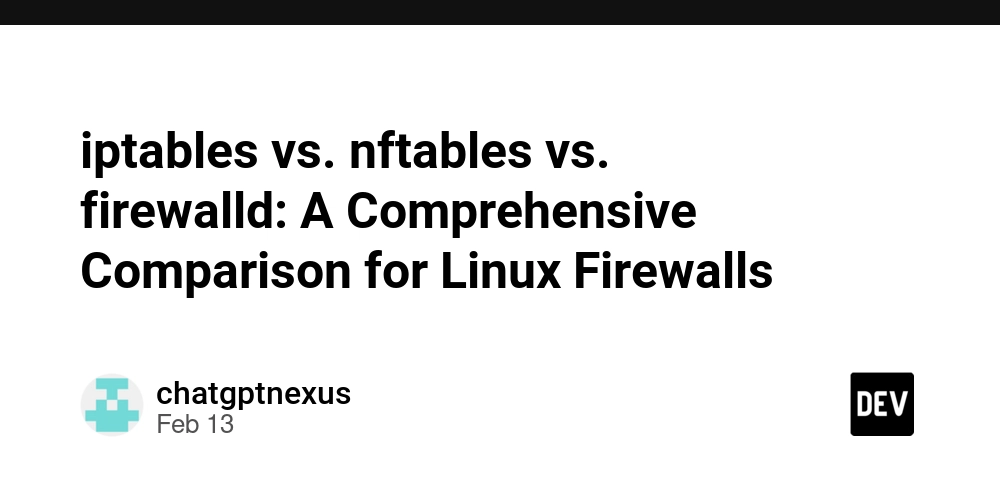iptables vs. nftables vs. firewalld: A Comprehensive Comparison for Linux Firewalls
In the ever-evolving landscape of Linux network security, understanding the differences between traditional tools like iptables and modern alternatives like nftables and firewalld is crucial for system administrators. This blog post delves into a comparison based on architecture, features, and syntax. Architecture Comparison Feature iptables nftables firewalld Kernel Module Multiple modules (ip_tables) Single nftables module Front-end, backend uses nftables Protocol Support Separate for IPv4/6 (ip6tables) Unified IPv4/6/ARP/bridge traffic Handles multiple protocols automatically Rule Storage Linear traversal of rule sets Red-black tree-based structure Dynamic rule management Performance Performance degrades with more rules 30% better rule matching efficiency Depends on backend engine performance Insight: With its single kernel module, nftables inherently offers better performance and scalability, managing rules more efficiently than iptables. NAT Configuration Comparison Traditional iptables MASQUERADE iptables -t nat -A POSTROUTING -o eth0 -j MASQUERADE Modern nftables Equivalent nft add table ip nat nft add chain ip nat POSTROUTING { type nat hook postrouting priority 100 \; } nft add rule ip nat POSTROUTING oifname "eth0" masquerade Advantage: Automatic compatibility with IPv4 and IPv6, clear priority settings. firewalld Rich Rule Example firewall-cmd --permanent --zone=public --add-rich-rule='rule family=ipv4 source address=192.168.1.0/24 masquerade' Advantage: Dynamic updates and policy grouping via zones. Feature Evolution Rule Tracing: nftables: Built-in trace for real-time rule matching monitoring. nft monitor trace iptables: Requires TRACE target and xtables-monitor. Batch Operations: iptables: Needs individual commands for each rule. nftables: Supports set operations for efficiency. nft add rule filter input tcp dport {22,80} accept IPv6 Support: iptables: Requires separate rules with ip6tables. nftables: Uses inet family for handling dual-stack traffic effortlessly. Migration Practices Conversion Tools: Use iptables-translate to convert existing iptables rules to nftables syntax automatically. Hybrid Operation: Implement iptables-nft for a smooth transition. Performance Tuning: With nftables, enable JIT compilation for enhanced performance: nft set ruleset optimize=full Conclusion: For new setups, nftables is highly recommended due to its superior performance, lower memory usage, and better manageability. Existing iptables rules can be migrated using available tools, making the transition less daunting. Firewalld, on the other hand, is ideal for environments needing dynamic firewall management with user-friendly interaction through zones. References: Netfilter's nftables Documentation Fedora's firewalld Introduction Performance Comparison of iptables and nftables OpenSUSE's Guide to nftables

In the ever-evolving landscape of Linux network security, understanding the differences between traditional tools like iptables and modern alternatives like nftables and firewalld is crucial for system administrators. This blog post delves into a comparison based on architecture, features, and syntax.
Architecture Comparison
| Feature | iptables | nftables | firewalld |
|---|---|---|---|
| Kernel Module | Multiple modules (ip_tables) | Single nftables module | Front-end, backend uses nftables |
| Protocol Support | Separate for IPv4/6 (ip6tables) | Unified IPv4/6/ARP/bridge traffic | Handles multiple protocols automatically |
| Rule Storage | Linear traversal of rule sets | Red-black tree-based structure | Dynamic rule management |
| Performance | Performance degrades with more rules | 30% better rule matching efficiency | Depends on backend engine performance |
Insight: With its single kernel module, nftables inherently offers better performance and scalability, managing rules more efficiently than iptables.
NAT Configuration Comparison
Traditional iptables MASQUERADE
iptables -t nat -A POSTROUTING -o eth0 -j MASQUERADE
Modern nftables Equivalent
nft add table ip nat
nft add chain ip nat POSTROUTING { type nat hook postrouting priority 100 \; }
nft add rule ip nat POSTROUTING oifname "eth0" masquerade
- Advantage: Automatic compatibility with IPv4 and IPv6, clear priority settings.
firewalld Rich Rule Example
firewall-cmd --permanent --zone=public --add-rich-rule='rule family=ipv4 source address=192.168.1.0/24 masquerade'
- Advantage: Dynamic updates and policy grouping via zones.
Feature Evolution
-
Rule Tracing:
-
nftables: Built-in
tracefor real-time rule matching monitoring.
-
nftables: Built-in
nft monitor trace
-
iptables: Requires
TRACEtarget andxtables-monitor.
-
Batch Operations:
- iptables: Needs individual commands for each rule.
- nftables: Supports set operations for efficiency.
nft add rule filter input tcp dport {22,80} accept
-
IPv6 Support:
-
iptables: Requires separate rules with
ip6tables. -
nftables: Uses
inetfamily for handling dual-stack traffic effortlessly.
-
iptables: Requires separate rules with
Migration Practices
-
Conversion Tools:
- Use
iptables-translateto convert existing iptables rules to nftables syntax automatically.
- Use
-
Hybrid Operation:
- Implement
iptables-nftfor a smooth transition.
- Implement
-
Performance Tuning:
- With nftables, enable JIT compilation for enhanced performance:
nft set ruleset optimize=full
Conclusion: For new setups, nftables is highly recommended due to its superior performance, lower memory usage, and better manageability. Existing iptables rules can be migrated using available tools, making the transition less daunting. Firewalld, on the other hand, is ideal for environments needing dynamic firewall management with user-friendly interaction through zones.
References:












































































































































































![[The AI Show Episode 142]: ChatGPT’s New Image Generator, Studio Ghibli Craze and Backlash, Gemini 2.5, OpenAI Academy, 4o Updates, Vibe Marketing & xAI Acquires X](https://www.marketingaiinstitute.com/hubfs/ep%20142%20cover.png)



























































































































![[DEALS] The Premium Learn to Code Certification Bundle (97% off) & Other Deals Up To 98% Off – Offers End Soon!](https://www.javacodegeeks.com/wp-content/uploads/2012/12/jcg-logo.jpg)


![From drop-out to software architect with Jason Lengstorf [Podcast #167]](https://cdn.hashnode.com/res/hashnode/image/upload/v1743796461357/f3d19cd7-e6f5-4d7c-8bfc-eb974bc8da68.png?#)








































































































.png?#)

































_Christophe_Coat_Alamy.jpg?#)
 (1).webp?#)





































































































![Apple Considers Delaying Smart Home Hub Until 2026 [Gurman]](https://www.iclarified.com/images/news/96946/96946/96946-640.jpg)
![iPhone 17 Pro Won't Feature Two-Toned Back [Gurman]](https://www.iclarified.com/images/news/96944/96944/96944-640.jpg)
![Tariffs Threaten Apple's $999 iPhone Price Point in the U.S. [Gurman]](https://www.iclarified.com/images/news/96943/96943/96943-640.jpg)




































































































































